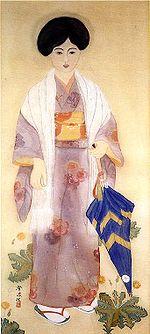
Tabi
Encyclopedia


Japan
Japan is an island nation in East Asia. Located in the Pacific Ocean, it lies to the east of the Sea of Japan, China, North Korea, South Korea and Russia, stretching from the Sea of Okhotsk in the north to the East China Sea and Taiwan in the south...
ese sock
Sock
A sock is an item of clothing worn on the feet. The foot is among the heaviest producers of sweat in the body, as it is able to produce over of perspiration per day. Socks help to absorb this sweat and draw it to areas where air can evaporate the perspiration. In cold environments, socks decrease...
s. Ankle-high and with a separation between the big toe and other toes, they are worn by both men and women with zori
Zori
are flat and thonged Japanese sandals made of rice straw or other plant fibers, cloth, lacquered wood, leather, rubber, or—increasingly—synthetic materials...
, geta
Geta (footwear)
Geta are a form of traditional Japanese footwear that resemble both clogs and flip-flops. They are a kind of sandal with an elevated wooden base held onto the foot with a fabric thong to keep the foot well above the ground. They are worn with traditional Japanese clothing such as kimono or yukata,...
, and other traditional thonged footwear. Tabi are also essential with traditional clothing—kimono
Kimono
The is a Japanese traditional garment worn by men, women and children. The word "kimono", which literally means a "thing to wear" , has come to denote these full-length robes...
and other wafuku as well as being worn by samurai in the feudal era. The most common colour is white, and white tabi are worn in formal situations such as at tea ceremonies
Tea ceremony
A tea ceremony is a ritualised form of making tea. The term generally refers to either chayi Chinese tea ceremony, chado Japanese tea ceremony, tarye Korean tea ceremony. The Japanese tea ceremony is more well known, and was influenced by the Chinese tea ceremony during ancient and medieval times....
. Men sometimes wear blue or black tabi for travelling. Patterned and coloured tabi are also available and are worn most often by women, though they are gaining popularity among men as well.
In contrast to socks that, when pulled on, fit the foot snugly because of their elastic weave, tabi are sewn from cloth cut to form. They are open at the back so they can be slipped on and have a row of fasteners along the opening so they can be closed.
Jika-tabi
Construction workers, farmers and gardeners, rickshaw-pullers, and other workmen often wear a type of tabi called . Made of heavier, tougher material and often having rubberRubber
Natural rubber, also called India rubber or caoutchouc, is an elastomer that was originally derived from latex, a milky colloid produced by some plants. The plants would be ‘tapped’, that is, an incision made into the bark of the tree and the sticky, milk colored latex sap collected and refined...
soles, jika-tabi resemble boot
Boot
A boot is a type of footwear but they are not shoes. Most boots mainly cover the foot and the ankle and extend up the leg, sometimes as far as the knee or even the hip. Most boots have a heel that is clearly distinguishable from the rest of the sole, even if the two are made of one piece....
s and are outer footwear rather than socks. Like other tabi, jika-tabi are toe-divided so they can be worn with slip-on thonged footwear. Shojiro Ishibashi
Shojiro Ishibashi
was a Japanese businessman who founded the Bridgestone Corporation, the world's largest maker of tires, in 1930 in the city of Kurume, Fukuoka, Japan. Bridgestone was named after its founder: In the Japanese language ishi means a "stone" and bashi mean "bridge"...
, the founder of major tire company Bridgestone Corporation
Bridgestone
The is a multinational rubber conglomerate founded in 1931 by in the city of Kurume, Fukuoka, Japan. The name Bridgestone comes from a calque translation and transposition of ishibashi, meaning "stone bridge" in Japanese....
, is credited with their innovation.
Though slowly being replaced by steel-toed rigid-sole construction shoes in some industries, many workers prefer them for the softness of their soles. This gives wearers tactile contact with the ground and lets them use their feet more agilely than rigid-soled shoes allow: for instance, people who traverse girders on construction sites like to know what is under their feet, and craft practitioners such as carpenters and gardeners additionally use their feet as if they were an extra pair of hands, for example to hold objects in place.
Modern versions
Nowadays, tabi socks—socks with a separation between the big toe and its neighbor to allow wear with thonged footwear—are also available. This reflects the number of people who still prefer to wear zoriZori
are flat and thonged Japanese sandals made of rice straw or other plant fibers, cloth, lacquered wood, leather, rubber, or—increasingly—synthetic materials...
and geta
Geta (footwear)
Geta are a form of traditional Japanese footwear that resemble both clogs and flip-flops. They are a kind of sandal with an elevated wooden base held onto the foot with a fabric thong to keep the foot well above the ground. They are worn with traditional Japanese clothing such as kimono or yukata,...
, especially during Japan's hot, humid summers.
A related item are toe socks
Toe socks
Toe socks are socks that have been knitted so that each toe is individually encased the same way as fingers within a glove....
, which have five separate compartments; these are called
(five-toe socks) in Japanese.

